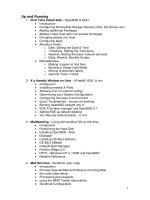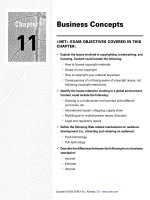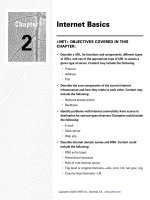Tài liệu Internet Basics pdf
Bạn đang xem bản rút gọn của tài liệu. Xem và tải ngay bản đầy đủ của tài liệu tại đây (1 MB, 32 trang )
Chapter
2
Internet Basics
i-NET+ OBJECTIVES COVERED IN THIS
CHAPTER:
Describe a URL, its functions and components, different types
of URLs, and use of the appropriate type of URL to access a
given type of server. Content may include the following:
Protocol
Address
Port
Describe the core components of the current Internet
infrastructure and how they relate to each other. Content may
include the following:
Network access points
Backbone
Identify problems with Internet connectivity from source to
destination for various types of servers. Examples could include
the following:
Slow server
Web site
Describe Internet domain names and DNS. Content could
include the following:
DNS entry types
Hierarchical structure
Role of root domain server
Top level or original domains—edu, com, mil, net, gov, org
Country level domains—UK
Copyright © 2000 SYBEX Inc., Alameda, CA. www.sybex.com
T
he Internet is a very complex entity. To understand the topics found
in later chapters in this book, you must first understand the underlying lay-
out and technologies of the Internet so that you have a common reference
point for those discussions. In this chapter, you will learn the following:
What the Internet is
Internet layout
Domain Name Services (DNS)
Uniform Resource Locators (URLs)
Internet communications process
Throughout this chapter, you will also learn the terminology of the
devices and processes used on the Internet. Let’s begin the discussion of these
topics with the definition of the Internet.
What Is the Internet?
T
he simplest definition of the
Internet
is that it is a collection of local
area networks connected together by high-speed public WAN connections.
Servers on these LANs provide information to the rest of the Internet in the
form of documents, images, and multimedia content. The information deliv-
ered by these servers is generally called
Internet content
. For a small fee, any-
one with a computer and a modem can access the Internet and get access to
this content. Figure 2.1 shows a graphical representation of the Internet.
Copyright © 2000 SYBEX Inc., Alameda, CA. www.sybex.com
What Is the Internet?
57
Notice how individual users and LANs connect to Internet Service Providers
(ISPs), which in turn can connect to other ISPs that connect to backbone
ISPs. Backbone ISPs are ISPs with very high-speed connections between them
(several hundred megabits per second). You will learn about ISPs in the sec-
tions to follow.
FIGURE 2.1
A graphical representation of the Internet
History of the Internet
The Internet started out as a project of the U.S. government’s Defense
Advanced Research Projects Agency (DARPA) in 1973. They wanted to
design a network that could reconfigure itself around breaks and faults in
case one of its nodes were taken out during a war. The architects of this net-
work, called ARPAnet, took this into consideration and developed a suite of
protocols (called TCP/IP) and a network that could do just that.
For more detailed information on TCP/IP, see Chapter 3.
Another network was developed in 1980 to connect IBM mainframes in
university data centers. This network was called BITnet, and it allowed uni-
versities to communicate with one another, thus facilitating collaboration
among professors at those universities with the first, primitive e-mail system.
ISP
ISP
ISP ISPISP
ISP
ISP
ISP
ISP
Backbone
ISP
Backbone
ISP
Backbone
ISP
Backbone
ISP
Copyright © 2000 SYBEX Inc., Alameda, CA. www.sybex.com
58
Chapter 2
Internet Basics
In 1983, the Internet Architecture Board (IAB) was formed to guide the
development of the TCP/IP protocol suite (the protocol used on the Inter-
net) and to provide research data for the Internet. The IAB consists of two
organizations, the Internet Engineering Task Force (IETF) and the Internet
Research Task Force (IRTF). The IETF is responsible for the ongoing devel-
opment of the TCP/IP protocol. When a new TCP/IP protocol is proposed,
the IETF issues a Request for Comments (RFC) that details the specifica-
tions of the new protocol and how it is to be used. The IRTF, on the other
hand, is responsible for researching new Internet technologies and their pos-
sible implications on the Internet as a whole.
RFCs can be found at
www.ietf.org
on the Internet.
In 1986, the National Science Foundation (NSF) developed NSFnet as a
backbone for the now-emerging Internet. It would connect the old ARPA-
net, BITnet, and a bunch of other networks together to form the Internet. At
this point, the Internet became very far reaching and very powerful as thou-
sands of people who were now connected to it could all communicate and
collaborate.
The Internet Today
Since the days of the NSFnet, ARPAnet, BITnet, and all the others, Internet
use has grown exponentially. No longer do only geeks and professors know
about it; it has become a part of popular culture. Every television commercial
ends with the company name and the address of the company’s Web site so
you can visit it and get even more information. One measure of a company’s
success is how many hits the company’s Web site gets per day.
It is estimated that in September 1999, there were more than 201 million
people worldwide on the Internet, and that number is estimated to double by
2001. Currently, more than 75 percent of all metropolitan areas in the United
States have Internet access. Basically, any household that has a phone line can
get access to the Internet (with either a local or a long distance phone call).
With each passing year, Internet access technologies allow faster access to the
Internet. Home access speeds are available from 33.6Kbps (modems) to
512Kbps (ISDN and DSL access). At these speeds, Internet content can
include streaming audio and video.
Copyright © 2000 SYBEX Inc., Alameda, CA. www.sybex.com
The Layout of the Internet
59
The Layout of the Internet
E
ven though the Internet is a constantly evolving entity, its areas can be
broken down into several basic classifications:
Access points (ISPs)
WAN connections
Backbone providers
Each classification deals with a particular section of the Internet, as shown
in Figure 2.2. Notice how the Internet areas connect to each other and what
types of connections are used between them.
FIGURE 2.2
Layout of the Internet
In the following sections, you will learn the details of each Internet area
and the responsibilities each area has within the Internet. You will also learn
which areas end users interact with and the different types of ISPs.
Access Points (ISPs)
As previously mentioned, anyone can get access to the information found on
the Internet, but first they must be connected to the Internet. The Internet has
often been called the “Information Superhighway.” I’d actually describe it as
an “Internet Tollway.” To get the benefits of the “highway,” you have to pay
to get on. Thus, in order to get on the Internet, you have to pay the people
WAN
connection
WAN
connection
WAN
connection
WAN
connection
WAN
connection
High-speed
WAN connection
ISP
ISP
ISP
ISP
Backbone
ISP
Backbone
ISP
Backbone
ISP
Copyright © 2000 SYBEX Inc., Alameda, CA. www.sybex.com
60
Chapter 2
Internet Basics
who have set up access points to it (similar to the on-ramps of the toll high-
ways). These access points are called Internet Service Providers (ISPs). An ISP
has a very high-speed connection (usually capable of transmitting several
megabits per second) to the Internet. The ISP then sells slower (several kilobits
per second) dial-up or dedicated connections.
ISPs usually have a high-speed LAN, with a large, complex router to con-
nect the LAN to the Internet. Then, on the ISP’s “backbone” (as shown in
Figure 2.3) are the ISP’s mail, news, and Web servers, as well as the routers
that provide dial-up and dedicated leased-line access to the Internet for the
ISP’s customers. Additionally, some ISPs sell “space” on their backbone to
companies so that those companies can place their Web servers directly on
the ISP’s backbone for the best possible performance. This practice is called
server hosting
. In Figure 2.3, notice where the ISP’s backbone is and what
items connect to it within an ISP. Also notice that the backbone connects to
a router that, in turn, connects the ISP to its own ISP.
FIGURE 2.3
A typical ISP setup
ISP backbone router
Internet or other ISP
server
Web (HTTP)
server
Customer Web server
Leased-line
router(s)
Dial-up
router(s)
Router
Leased line
CSU/DSU
CSU/DSU
Multiple WAN
connections
ISP backbone
Customer LAN
POTS
Copyright © 2000 SYBEX Inc., Alameda, CA. www.sybex.com
The Layout of the Internet
61
ISPs can be found in every major city in the U.S. and in almost every rural
area. In Europe and the Asian countries, ISPs can be found in the larger cities.
However, the Internet’s reach is expanding more and more every day. Very
soon it will be possible to get Internet access anywhere on (or off) Earth.
To find an ISP in your area, you can look in the Yellow Pages under “Internet
providers,” or, if you can get to a machine connected to the Internet, check out
The List of ISPs at
.
WAN Connections
If the Internet were a living entity, the ISPs would be its appendages and the
WAN connections would be the arterial connections between them. A wide
area network (WAN) connection is a special phone line that is leased from
the local telephone company and used to carry data between two LANs. For
our discussion, WAN connections connect two ISPs to provide the Internet
with its structure.
WAN connection speeds range from 9600bps to hundreds of megabits
per second (Mbps). These WAN connections were covered in detail in Chap-
ter 1, but to summarize, Table 2.1 illustrates some WAN technologies and
their associated speeds.
TABLE 2.1
Common WAN Connection Technologies
WAN Connection Common Speed(s)
DDS 56Kbps
Frame Relay 56Kbps–1.544Kbps
T1 1.544Kbps
T3 44.736Mbps
ISDN 128Kbps–2Mbps
ATM 155Mbps
Copyright © 2000 SYBEX Inc., Alameda, CA. www.sybex.com
62
Chapter 2
Internet Basics
For more information on WAN technologies and their speeds, refer to
The
Network Press Encyclopedia of Networking
by Werner Feibel (Sybex, 2000).
Backbone Providers
Although the Internet is essentially a network of ISPs, there are a few select
ISPs that connect to each other with high-speed WAN connections to pro-
vide the Internet with a “backbone.” These ISPs are known as
backbone
providers
(as shown earlier in Figure 2.2) and connect to each other at
speeds from 100Mbps to 1Gbps. The
Internet backbone
is the set of high-
speed WAN connections, servers, and ISPs that provide the structure for the
Internet.
Many ISPs claim to be backbone providers, but this is usually a marketing
gimmick and means that they connect directly to an actual backbone pro-
vider but are not actually part of the Internet backbone. Most backbone pro-
viders are divisions of telephone companies and are called
Network Access
Points
(
NAPs
). Sprint and Pacific Bell are examples of NAPs. Originally,
there were four major NAPs that connected the Internet. Since that time, sev-
eral new NAPs have been added, like ICS and Worldcom.
Internet2: The Next Generation
The current Internet has seen many advancements, but there are even more
Internet technologies are waiting to be developed, technologies such as
IPv6, Quality of Service (QoS), Telemedicine, video multicasting, and many
others. A number of them will improve collaboration abilities and directly
benefit higher education (as did the technologies of the current Internet).
For this reason, a consortium of higher education institutions have gotten
together and formed the University Corporation for Advanced Internet
Development (UCAID). One of UCAID’s projects is
Internet2
(
I2
), the collec-
tion of next-generation Internet applications and technologies being devel-
oped for use with the Internet infrastructure in use today. Internet2 is not its
own network, as some people incorrectly assume. It is only the name given
to the ongoing research of these technologies and their possible applica-
tions. Just as the current Internet technologies have their roots in the col-
laboration efforts of education, it is the hope of the UCAID that the work
done with Internet2 will increase the Internet’s usability. For more informa-
tion, visit UCAID at
www.ucaid.edu
.
Copyright © 2000 SYBEX Inc., Alameda, CA. www.sybex.com
Domain Name Services (DNS)
63
Domain Name Services (DNS)
D
omain Name Services (DNS) is a network service that associates
alphanumeric host names with the TCP/IP address of a particular Internet
host. When surfing the Web, you could refer to a host by its IP address (for
example, 201.35.124.12), but it is more common to use a DNS host name
(
www.sybex.com
). Internet host names are used because they are easier to
remember than long, dotted-decimal IP addresses. In this section, you will
learn what a domain is, how domains are organized within DNS, and the
specifics of how to use DNS.
What Are Domains?
Host names are typically the name of a device that has a specific IP address,
and on the Internet, they are part of what is known as a
fully qualified
domain name.
A fully qualified domain name consists of a host name and
a domain name.
Although you have a Social Security number and can remember it when
you need it, life would be difficult if you had to remember the Social Security
numbers of all your friends and associates. You might be able to remember
the Social Security numbers of as many as 10 friends and relatives, but after
that things would get a bit difficult. Likewise, it’s easier to remember
www
.microsoft.com
than it is to remember 198.105.232.6.
The process of finding the host name for any given IP address is known as
name resolution,
which can be performed in several ways, and we’ll look at
all of them in the next few sections. But first you need to understand Internet
domains and how they are organized.
Internet Domain Organization
On the Internet, domains are arranged in a hierarchical tree structure. There
are seven top-level domains currently in use:
com
A commercial organization. Most companies will end up as part of
this domain.
edu
An educational establishment, such as a university.
gov
A branch of the U.S. government.
int
An international organization, such as NATO or the United Nations.
Copyright © 2000 SYBEX Inc., Alameda, CA. www.sybex.com
64
Chapter 2
Internet Basics
mil A branch of the U.S. military.
net A network organization.
org A nonprofit organization.
Unfortunately, the word domain is used in several ways, depending on the
context. When the topic is the Internet, a domain refers to a collection of net-
work host computers.
U.S. Domains
Your local ISP is probably a member of the net domain, and your company
is probably part of the com domain. The gov and mil domains are reserved
strictly for use by the government and the military within the United States.
The com domain is by far the largest, followed by the edu domain, and well
over 130 countries are represented on the Internet.
New U.S. Domains
Because the com domain is so popular, almost every company has a Web
address that ends with .com. Additionally, there are no divisions in any of
the domains, especially the com domain. For these reasons, the Internet
Assigned Numbers Authority (IANA) has come up with some new top-level
domains to further segment the U.S. Internet DNS space, for example:
firm Designed for naming businesses or firms
shop Domain for online shopping centers
web Domain for Web sites relating to information about the WWW
info Domain used for Web sites that provide some useful information to a
community (like a community billboard)
arts Domain for cultural and entertainment organizations
rec Domain for completely recreational Web sites
nom Domain for an individual person’s name
Copyright © 2000 SYBEX Inc., Alameda, CA. www.sybex.com
Domain Name Services (DNS) 65
International Domains
In other parts of the world, the final part of a domain name represents the
country in which the server is located: ca for Canada, jp for Japan, uk for
Great Britain, and ru for Russia, for example. Figure 2.4 shows an example
of the layout of the Internet DNS hierarchy. Notice how the com, edu, and
international domains are all at the same level.
FIGURE 2.4 Internet DNS domain hierarchy
If you want to contact someone within one of these domains by e-mail,
you just add that person’s e-mail name to his domain name, separated by an
at sign (@). For example, if you want to e-mail the president of the United
States, send your e-mail to this address:
InterNIC assigns all Internet domain names and makes sure no names are
duplicated. Names are assigned on a first-come, first-served basis, but if you
try to register a name that infringes on someone else’s registered trademark,
your use of that name will be rescinded if the trademark holder objects.
Now that we have detailed how Internet domain names work and where
they came from, we can return to our discussion of name-resolution methods.
NET GOV COM MIL EDU ORG DE AU
SYBEX YAHOO NOVELL
WWW FTP MAIL NEWS
U.S. Domains International Domains
Copyright © 2000 SYBEX Inc., Alameda, CA. www.sybex.com
66 Chapter 2
Internet Basics
Using DNS
The abbreviation DNS stands for Domain Name Services. You use DNS to
translate host names and domain names to IP addresses, and vice versa, by
means of a standardized lookup table that the network administrator defines
and configures. The system works just like a giant telephone directory.
Suppose you are using your browser to surf the Web and you enter the
URL to go to the Microsoft home page. Your
Web browser then asks the TCP/IP protocol to ask the DNS server for the IP
address of www.microsoft.com. When your Web browser receives this
address, it connects to the Microsoft Web server and downloads the home
page. DNS is an essential part of any TCP/IP network, simplifying the task
of remembering addresses; all you have to do is simply remember the host
name and domain name.
The DNS tables that are used to resolve the host name to an IP address are
composed of records. Each record is composed of a host name, a record type,
and an address. There are several record types, including the address record,
the mail exchange record, and the CNAME record.
The address record, commonly known as the A record, directly maps a
host name to an IP address. The example below shows the address record for
a host called mail in the company.com domain:
mail.company.com. IN A 204.176.47.9
The mail exchange (MX) record points to the mail exchanger for a partic-
ular host. DNS is structured so that you can actually specify several mail ex-
changers for one host. This feature provides a higher probability that e-mail
will actually arrive at its intended destination. The mail exchangers are listed
in order in the record, with a priority code that indicates the order in which the
mail exchangers should be accessed by other mail delivery systems.
If the first priority doesn’t respond in a given amount of time, the mail
delivery system tries the second one, and so on. Here are some sample mail
exchange records:
host.company.com. IN MX 10 mail.company.com.
host.company.com. IN MX 20 mail2.company.com.
host.company.com. IN MX 30 mail3.company.com.
In this example, if the first mail exchanger, mail.company.com, does not
respond, the second one, mail2.company.com, is tried, and so on.
Copyright © 2000 SYBEX Inc., Alameda, CA. www.sybex.com









